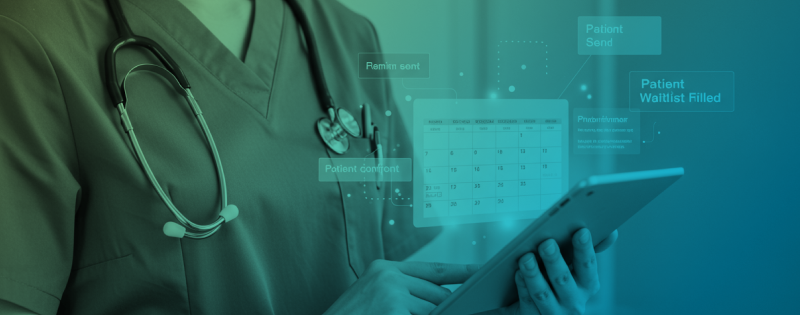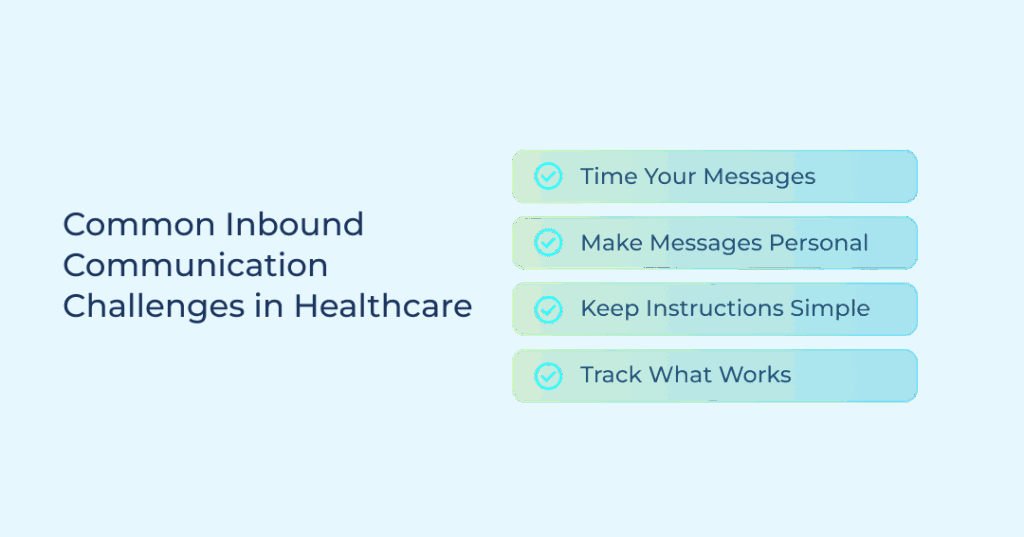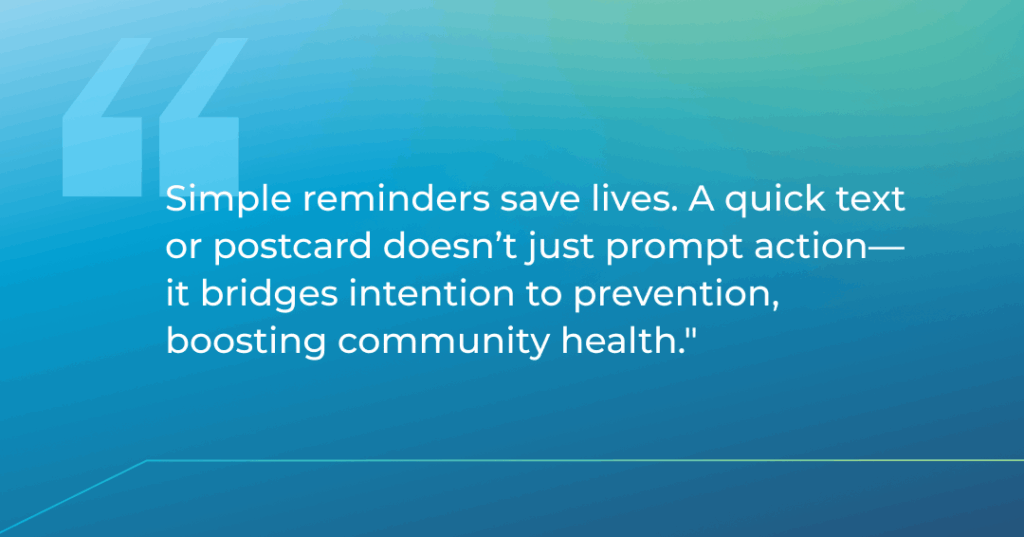Last flu season claimed the lives of more than 200 children in the United States,…

How SMS and Postcard Reminders Drive Higher Vaccination Rates
Each flu season starts with thousands of people intending to get vaccinated, but they never actually do. They either keep delaying or forget their appointments altogether, creating an unnecessary strain on our public healthcare systems.
Well-timed and thought-out reminders help close these gaps. A vaccination postcard becomes a physical reminder for days or weeks, while SMS can nudge someone instantly.
Together, they encourage patients to follow through, helping communities stay protected with higher vaccination rates.
Why Patients Miss Vaccinations and What Needs to Change
Patients skip vaccines for three main reasons: they either forget, can’t access care easily, or don’t know they need them.
The biggest culprit is simple forgetfulness. Your children get their first round of vaccines as babies, but you forget about their annual boosters by the time they start school. It’s also common for adults to downplay the need for flu vaccines every year.
Speaking of adults, their work schedules create another hurdle. Taking time off from work for a routine vaccine is too much of a hassle, so they keep rescheduling their appointments.
Access issues further compound the problem. Rural families have to drive an hour to reach the nearest clinic. Urban patients wait weeks for appointments. Insurance confusion also adds to the issue, making people avoid routine care altogether, especially if they’re unsure about coverage.
SMS vaccination reminders and postcard vaccine reminders smash through these barriers. They arrive when you’re busy with your work or chores, and interrupt your routine with useful information.
A text message might catch you during your commute. A postcard will wait in your mailbox alongside bills and letters until you’re ready to view it. It’s why some postcards now include QR codes that take you straight to the scheduling page, making it easy to book an appointment instantly.
Healthcare systems that send automated vaccine reminders actually have more patients keep themselves up to date on their immunizations. These reminders are a big factor in enhancing decision-making.
The Psychology Behind Reminder Effectiveness
SMS reminders boost vaccination rates by 2-11% in various vaccine campaigns. That’s based on a recent study to cement further how behavioral science supports the power of reminders.
Nudging patients with reminders works because they interrupt normal routines at exactly the right moment. However, the goal here is to create urgency instead of panic. It’s the difference between a good and a bad reminder.
A postcard that says “Your flu shot is due this month” feels different than remembering three months later that you never got one. Similarly, a postcard followed by a text message creates two opportunities for action.
Trust matters enormously as well. You ignore spam texts but pay attention to messages from numbers you recognize. Vaccination reminders from your actual healthcare provider carry authority that generic public health campaigns lack.
The key is making action easy. Postcards feel personal, texts spark instant action. Together, they work because they reach people at the exact moment they’re ready to follow through.
The Impact of Multi-Channel Outreach: SMS + Postcards
Healthcare systems need direct communication to reach patients who miss vaccination reminders. Two methods stand out for their distinct advantages: text messages for immediate reach and postcards for lasting visibility. Each serves different patient populations and addresses unique barriers to vaccine appointment reminders.
Role of SMS
SMS vaccination reminders deliver immediate results because patients are already glued to their phones most of the day. Nearly 90% of texts get read within 3 minutes, so your messages are guaranteed to capture a patient’s attention when it matters. This speed prevents the common scenario where patients forget again after seeing a reminder, making it easy for them to confirm or reschedule on the spot.
SMS campaigns are also cheaper than phone calls or postal mail. Healthcare systems can reach thousands of patients for pennies per message. Additionally, they work across different demographics without losing effectiveness. Both rural and urban populations show the same response rates.
Role of Postcards
Postcards’ lasting visibility is something digital messages can’t match. Unlike texts, postcard vaccine reminders stick around on your kitchen counters and desks for weeks. Some postcards include QR codes, providing an immediate way for patients to schedule appointments and increasing the likelihood they’ll act on the reminder. This physical presence gives patients multiple chances to notice and act on the reminder over time.
The format also has enough space for detailed information, including maps, multiple appointment options, and visual elements that build trust and credibility with healthcare providers.
Elderly populations, often not that comfortable with tech, and families without consistent mobile service benefit the most from postal delivery. 65+ patients are known to show increased vaccination rates for influenza, tetanus, pneumonia, and shingles if they received the postcard early in the intervention period.
Combining Both: The Hybrid Advantage
Using SMS vaccination reminders and postcard vaccine reminders together improves your chances of reaching out to patients. Think of it as creating a safety net to ensure nothing slips through.
It begins with a postal reminder weeks in advance, while text messages nudge patients when action is needed. This dual approach addresses different patient preferences and technological comfort levels within the same household.
Such a hybrid method is also needed when it comes to complex vaccination schedules that require multiple doses. Here, you need constant reminders to ensure patients stay updated for every dosage. Postcards serve to build initial awareness, while automated vaccine text reminders handle the time-sensitive follow-ups.
Best Practices for SMS and Postcard Vaccine Reminders
It goes without saying that our health systems are constantly under pressure to maintain high vaccination rates. Interventions such as vaccination reminder postcards and text messages are gaining the most attention since they help improve appointment attendance. Below are some key practices for you to consider in that regard.

Time Your Messages
Send the first vaccination reminder a week before the appointment to give families time to prepare, and a second reminder 24 hours before the visit to keep it fresh in their minds.
Make Messages Personal
Personalize your reminders by including the patient’s name, appointment date and time, and vaccine details. “Sarah has a flu shot appointment on Tuesday at 2 PM” is much more effective than a “reminder for a flu shot.” It sounds personal and makes parents more likely to take notice.
Keep Instructions Simple
Parents are busy, so your reminder should tell them exactly what to do, how to do it, and when. Instead of “Please contact us,” a clear message would be: “Call 555-123-4567 today to confirm Sarah’s vaccines.” For texts, include a clickable phone number or a direct link to your patient portal so parents can confirm or schedule appointments instantly. The fewer steps parents have to take, the better.
Track What Works
Try out different types of reminders with small groups first. Then, compare how many families show up with and without reminders. This way, you’ll know which style gets the best results.

Scaling Effective Outreach With TeleVox Pharma Edition
Running a nationwide vaccine campaign takes more than spamming generic reminders after reminders. You need a system built to handle scale without losing the personal touch. TeleVox’s Pharma Edition helps pharma teams design outreach that patients are more likely to notice and act on.
Built on our proven Patient Relationship Management platform, it gives pharma teams the ability to coordinate SMS and postcard outreach, automate delivery schedules, segment audiences, and track engagement through clear reporting and diagnostic analytics.
Forget about juggling multiple vendors or wrestling with disconnected tools. Everything runs under a single system that was designed with patients, providers, and pharma in mind.
The resulting outreach feels personal to every recipient because it’s consistent and well-timed, while giving teams the visibility and control they need at scale. The best way to see how seamlessly it all comes together is to schedule a demo and experience our platform in action.



